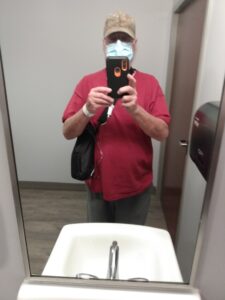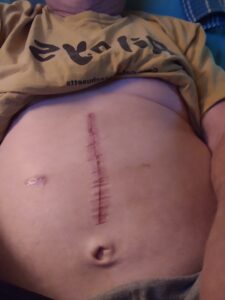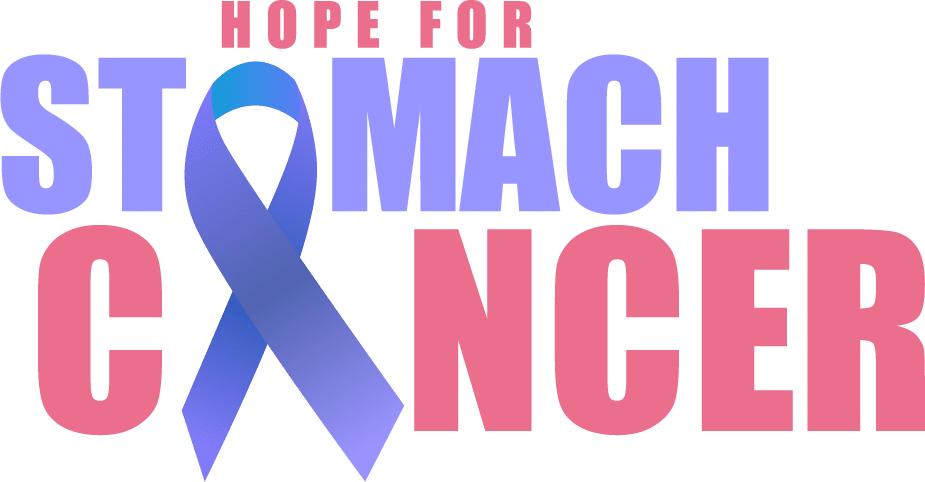Randy Geisel of Lancaster County, PA, received a stomach cancer diagnosis in October of 2021. Initially, doctors thought he had esophageal cancer, but their opinions changed after discovering a tumor in the upper part of his stomach. He endured a total gastrectomy and multiple rounds of chemo. This is his story of hope.
In October of 2021, my wife had a case of bronchitis, and I picked up similar symptoms. It ran its course, but I had a lingering sense of discomfort. It felt as if a potato chip was stuck in my throat. Oddly enough, I’d get these pains that would originate in my side and shoot up between my shoulder blades. The issues persisted throughout the winter.
Seeking Answers
At the time, I worked as a mail carrier. My job would be switching to new insurance at the beginning of the coming year, and I knew I wanted to get checked out once the insurance went into effect. My primary doctor referred me to a GI specialist for an endoscopy. I didn’t have to wait long for answers – the GI doctor conducted an endoscopy on February 8th and told me that day that there was a tumor in my esophagus.
I was stunned by the news. I’ve smoked cigarettes for most of my life, so if I were to have any form of cancer, I assumed it’d be in my lungs. We’d had some colon cancer in my family, and my mom passed away from multiple myeloma, a form of blood cancer. I didn’t expect this. But even though I was taken aback by my esophageal cancer diagnosis, I didn’t question why, or wonder how it happened. I accepted it and prepared myself for whatever would come next.
 Starting Treatment
Starting Treatment
The endoscopy seemed to irritate the tumor in my esophagus. I struggled to eat, and within days, I could only swallow food no thicker than pudding. I did not like the hospital the oncologist was associated with, so he suggested a few other hospitals and I settled on Penn State Milton S. Hershey Cancer Center for surgery and Wellspan Ephrata Cancer Center for chemotherapy. I met with the surgeon at Hershey for more tests, including an ultrasound endoscopy. When I came to after that procedure, the doctor asked me to clarify my diagnosis. I told him I had esophageal cancer. Well, he had news for me – there was a tumor in the top of my stomach that the prior endoscopy hadn’t picked up.
So, I got my official diagnosis: adenocarcinoma of the GE junction. Next, I had to undergo scans and a laparoscopy for staging. Since there were a couple of tumors, we needed to move fast. I started FLOT chemotherapy in March of 2022.
Truth be told, the four rounds of FLOT were fairly easy. I’d be down for a few days after my treatments, but then I’d still feel like my old self again. Receiving a bag of IV fluids after treatment helped with the fatigue and chemo brain (foggy-headedness) The weeks passed by, and before I knew it, it was time for my total gastrectomy.
The Total Gastrectomy
Right before my total gastrectomy, I had a final laparoscopy. This procedure showed a suspicious spot in my peritoneum. The surgeon didn’t think it looked malignant, but she sent a sample off for testing, just in case. As the surgery was underway, the pathology department contacted the surgeon and told them to stop – they wanted to do further testing on the suspicious spot. The surgeon closed me up.
Honestly, I was livid when I woke up. I’d prepared myself for surgery, only to discover that it wasn’t going to happen. I spent the night at the hospital and went home the next day.
Moving Forward with the Total Gastrectomy
Thankfully, they discovered that the spot on my peritoneum was just scar tissue from other procedures. The whole debacle set us back about a week, but they brought me back in for surgery as soon as they could.
During surgery, they found a spot on my diaphragm as well, which they were able to remove. It’s good that the spot was hidden – otherwise, she might have told me I wasn’t a candidate for surgery. In addition to that spot, she removed the bottom part of my esophagus and my entire stomach.
I spent a week recovering in the hospital. Honestly, the surgery and recovery period were pretty easy for me. I only felt pain if I stood up or used my stomach muscles. Within a few days, I was up and moving so frequently that they had to turn off my alarms.
When I got home, I faced Dumping Syndrome occasionally. My fault, because I was pushing my eating limits to form a pouch in my small intestines that would take the place of my stomach.
 Continuing Chemotherapy
Continuing Chemotherapy
Although the total gastrectomy wasn’t a huge challenge for me, the last four rounds of FLOT were horrible. After round one, I had a reaction to the oxaliplatin that caused a rash on my entire body. After round two, I developed drop foot, a condition that impairs the up and down movements of the foot. I powered through and finished the last two rounds (without oxaliplatin). Eventually, I regained full use of my foot, but it took time to heal.
This wasn’t the only change in my body that I noticed over the course of my treatment. When I first got my diagnosis, I weighed 225 pounds. I dropped to 179 after my surgery, and by the time I finished those final rounds of FLOT, I hit 165.
Follow Up Scans + Lung Problems
After the four rounds of FLOT, I started going in for CT scans every three months. I had a clean CT scan in September of 2022, but when I had a follow-up in December, they discovered a nodule on my lung. The oncologist wasn’t automatically concerned about it, as many people have modules on their lungs. However, when my next scan occurred in April 2023, we discovered that the nodule had evolved into a mass.
Originally, my care team thought it was new lung cancer and planned on surgery to remove the middle lobe of my right lung. We did a PET scan, which showed that I had multiple growths in my right lung and on my 12th rib. I had biopsies that revealed malignant fluid surrounding my right lung. It was partially collapsed. Pathology results deemed this as a recurrence. My oncologist was very forthright with me: I could forgo treatment and expect to live 3-6 months, or I could try treatment and hopefully live for six months to a year.
Pursuing Treatment Again
I chose to keep fighting. The doctor started me on chemo again – this time, it was a combination of FOLFIRI and Opdivo. Specialists had to drain two liters of fluid from my lung every few days. Thankfully, the FOLFIRI and Opdivo combination isn’t as debilitating for me as was the post-surgery FLOT. I managed these chemo treatments quite well. By the 7th or 8th round, we could tell it was working because I didn’t need my lung drained anymore.
Of course, I was relieved. As of June 2023, all cancer that was there in April is gone and I am currently NED. My oncologist can’t guarantee there are no microscopic cancer cells floating around, therefore I’ll need chemotherapy for the rest of my life. Even though this prospect is intimidating, I can manage FOLFIRI fairly well. Constipation and diarrhea are some of the main side effects, along with some fatigue right after treatments. Thankfully, after a day of recovery, I can usually return to the daily activities that I enjoyed before cancer.
My Hope for the Future
I dream of a day when we have a cure for this disease. Of course, this will benefit everyone who is facing uncertainty because of stomach cancer. For myself, I just want to keep feeling good. I can live with doing chemo every two weeks. I’m not even afraid of dying, but I don’t want to suffer and be bedridden.
My focus for now is spending time with my family and doing things I love. My wife has been an absolute lifesaver – there is no way I could have endured this without her by my side. She stepped in and cared for me, while caring for our two grandchildren, our home, the bills, and everything else. I am grateful for her and for the support I’ve had from everyone as I’ve faced stomach cancer.

